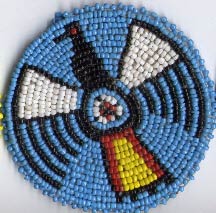
American Indian beads were originally carved from shells, coral, turquoise and other stones, copper and silver, wood, amber, ivory, and animal bones, horns, and teeth. Glass beads were not part of the Indian crafts scene until the colonists brought them to the Americas from Europe 500 years ago and they quickly became part of American Indian culture.
Today glass beads, particularly fine seed beads, are the primary materials for traditional beaders in many tribes. There are as many different American Indian beading traditions, designs, styles and stitches as there are tribes and nations.
Tribal Traditions:
Plains Indians – peyote stitch beading and bone hairpipe chokers.
Eastern Indians – wampum belts
West Coast Indians – dentalium strands
Northern Indians – floral beadwork
southwest Indians – shell and turquoise heishi beads
Beads were a common trade item since ancient times, so it wasn’t surprising to see abalone shells from the west coast in Cherokee beadwork or quahog wampum from the east coast in Ojibway beadwork, even before the Europeans arrived and forced disparate tribes into closer contact with each other.
Generally, native beadwork can be grouped into beaded leather (clothing, moccasins, containers) and beaded strands (jewelry, but occasionally ornamental covering to wrap gourds or other ceremonial or art objects).
For beaded leather arts, Indian craftspeople sew each bead onto a leather backing (or cloth, today). A related craft, quillwork, involved softening and dying stiff porcupine quills and affixing them to leather, birchbark, or to other crafts.
Indian quillwork died out as an art form mostly when seed beads became available to the northern and Plains tribes, but today some native artists are taking a renewed interest in quilling. As for beaded strands, Indian craftspeople stitch the beads together into strings or a mesh, using sinew, thread or wire. Beading strands and beading onto leather are both very complicated, time-consuming and delicate tasks which require many years of practice to do well.





